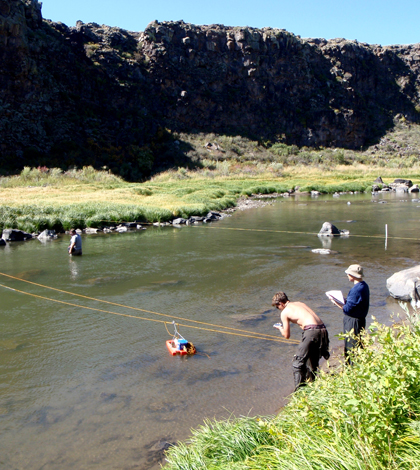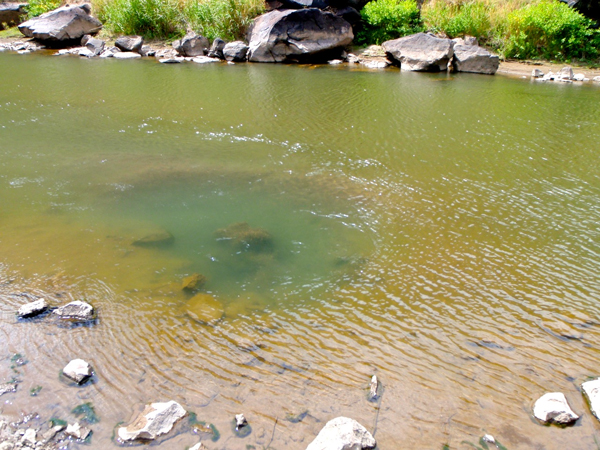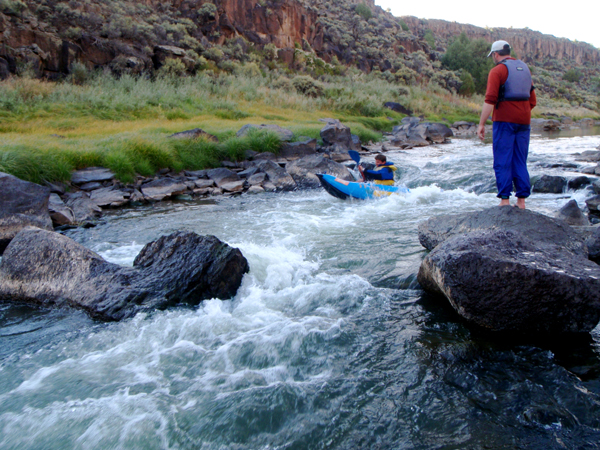Research expedition down Rio Grande tracks groundwater additions with ADCP

When a group of researchers in inflatable kayaks heard a hissing sound in the midst of a three-day float down the Rio Grande River, they thought they were in trouble.
“We were thinking, ‘Oh my god, somebody’s boat sprang a leak,'” said Kristoph Kinzli, assistant professor in Florida Gulf Coast University’s department of environmental and civil engineering.
Kinzli and eight colleagues were on the upper Rio Grande in 2008 to measure how much groundwater flows into the river after it crosses the Colorado border and flows into New Mexico. It’s a dry region with ever-increasing demand for water, so tracking every cubic foot of current counts. The group chose boats over hiking in part because this remote, 30-mile stretch carves through 850-foot canyons and poison ivy-lined banks, making the water nearly inaccessible. Losing a boat would be a problem.
Luckily, the hiss wasn’t coming from hole in a boat. Rather, it was a hole in the river bed where a huge spring blasted fresh groundwater into the stream with enough force to lift inch-wide stones up into the water column. What they heard was the churning plume of gravel that hovered over the spring—the muted sound of stones continuously tumbling and colliding underwater.
The researchers expected to see springs, but nothing this big, Kinzli said. Though they weren’t the first humans to see it, the spring was scientifically undocumented until recently.
“To see the magnitude of that was amazing,” Kinzli said. “It’s a pretty significant contribution to the river.”

The spring
Measuring groundwater contributions to the Rio Grande is what brought the team to the river in the first place. The Rio Grande flows from its headwaters in Colorado through New Mexico and into Texas, and all three states depend on the river and its groundwater resources for irrigation, drinking water, and wildlife habitat. A legal agreement called the Rio Grande Compact makes sure each state gets its share of water while leaving enough for the next state downstream.
Research like this helps states comply with the compact, said Rolf Schmidt-Petersen, Rio Grande basin manager for New Mexico’s Interstate Stream Commission, a state agency that regulates water resource issues.
Understanding groundwater is important because it’s less vulnerable to climate fluctuations than melting snow, which is the major source of river water in the West. Officials already knew that groundwater flows into this stretch of the Rio Grande, but they wanted a better estimate of how much and where it was getting in, said Schmidt-Petersen, who was also part of the kayak expedition.
“We were trying to do a better job of quantifying spring inflow,” he said. “We wanted to get a real feel for where those were coming in.”

The researchers travelled the river by kayak
As the researchers floated down the river they stopped at six sites to measure the current with an acoustic Doppler current profiler and another two sites with a standard propeller meter. By measuring the discharge at one site and subtracting an earlier discharge measurement at an upstream site, the researchers were left with how much groundwater had entered the river between the sites.
For example, around 20 miles into the trip, the crew measured the current near Sunshine Valley at 80 cubic feet per second (CFS). Twenty hours earlier, this water was still flowing past the Colorado border, and a stream gauge there read only 60 CFS. That extra 20 CFS came from groundwater flowing through springs or seeping into the channel.
In all, the 30-mile stretch of the river downstream from the Colorado border gains 22 CFS of groundwater, according to the study results published in the journal River Research and Applications. That’s within the range calculated by previous studies, but Kinzli said he puts more stock in this study than past estimates because the Doppler profiler is so much quicker and more accurate than other methods.
Measuring current with a hand held propeller meter can take two hours at a single site, where the Doppler profiler can do the work in ten minutes, he said.
“It just collects so much more data so much more quickly than historical meters that were used,” he said. “It is a night and day difference.”




0 comments